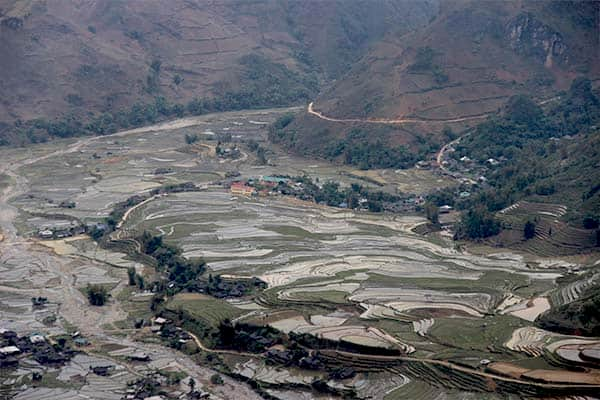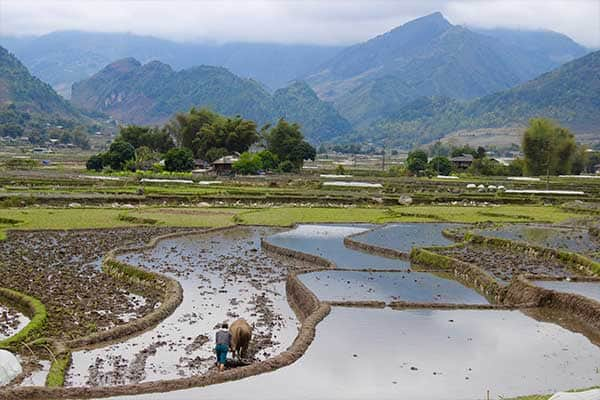MU CANG CHAI - NORTHERN VIETNAM
FABULOUS RICE TERRACES
Located
at the foot of the Hoang Lien mountain range, at an altitude of 1,000 metres
above sea level, Mu Cang Chai is an uncommon destination in Northern Vietnam
with high wooded mountains, deep valleys and beautiful waterfalls. Terraced
fields can be found in many mountainous provinces in Northern Vietnam, but the
most majestic are in Mu Cang Chai district in Yen Bai province.
Rice terraces in Mu Cang Chai
The terraced landscape of Mu Cang Chai is representative of the harmonious interaction of a living culture with nature. With great ingenuity, the local culture has surpassed the difficult natural conditions of the mountain. Despite unfavourable circumstances, farmers have applied scientific knowledge and spiritual beliefs and rituals to maximize annual harvests.
Since water and irrigation systems play a vital role in the rice field, the local people have developed water distribution channels to cope with the lack of water resources and the particular high altitude topography. They used bamboo pipes to draw water from the mountain, at an altitude of 1,000 metres, while preventing it from flowing. At the same time, the inhabitants practice rituals to "use the wind and rain" to regulate rainfall, the main water resource that supplies the rice fields, in addition to the many streams from the rocky mountain.

The landscapes of terraced rice fields in Mu Cang Chai
The
Mu Cang Chai rice fields are also home to a wide range of minority ethnic
groups in Northern Vietnam such as the Hmong, Dao, Thai, etc. Comprising 95% of
the population living around the slopes, the Hmong group was the first ethnic
group to settle in this mountainous and hilly region of northern Vietnam. As a
result, the history of these rice terraces is closely linked to the history of
the Hmong. When visiting Mu Cang Chai today, visitors are amazed by the unique
local way of life, which seems far removed from the so-called modern lifestyle
of large cities. Living in the steep mountains, most people still practice
fallow farming as their main agricultural activity, apart from rice
cultivation. In addition to working in the fields, their daily lives revolve
around their homes, animal husbandry, crafts, tributes to their ancestors and
the local market where local social and economic activities take place.
When to Visit Mu Cang Chai?
Mu Cang Chai can be visited at any time of the year thanks to its pleasant and cool climate. However, two times of the year are considered the best time to take beautiful pictures of rice fields: between May and June - the time of the waterfall; and between late September and early October - the time of the rice terraces.
Between May and June, the inhabitants use the water flowing from the Hoang Lien mountains to drop into their fields and start their new harvest. The water flowing from the streams looks like sparkling mirrors reflecting the blue sky, white clouds and working areas in the fields.
Between mid-September and mid-October, all the mountainous slopes of the rice terraces change colour from green to golden. This is the best time to take superb photos of Mu Cang Chai's breathtaking landscapes. It is also the time when the fields are full of life: Hmong farmers in their colourful clothes harvest ripe yellow rice across the valleys and mountains.
The
choice of time is therefore important when planning your trip to Northern Vietnam and your visit to Mu Cang Chai.
What to see in Mu Cang Chai?
Khau
Pha Pass
Khau
Pha Pass is one of the longest and most winding roads in Vietnam. It is located
on Route 32 and extends over 30 km. At an altitude of 1,200 to 1,500 m, Khau
Pha enjoys a cool climate all year round with four seasons in a single day and
often covered by a mist that seems to see its top rise from the clouds far
away. In the language of the Thai people, Khau Pha means "horn of
heaven" or "gate of heaven".
Village
Tu Le
The
village of Tu Le attracts visitors with its natural beauty and its fields. In
addition, you can experience the hot spring bath, which is one of the
traditional customs of the Thai people.
Hamlet
of Lim Mông
From the Khau Pha Mountain Pass, you will see a tiny and narrow road that leads to the hamlet of Lim Mong, a small village hidden in mist and clouds. To get there, scooters can be used for about two-thirds of the trip, and the rest can be walked on foot due to the steep and slippery slopes. The hamlet is also famous for its landscapes during the harvest season, when all the corners are dyed with the yellow colour of the rice fields.

Countryside in Mu Cang Chai
Village
of La Pan Tan
Thanks
to the picturesque fields, La Pan Tan, with De Xu Phinh and Che Cu Nha, are the
three villages considered as Vietnam's national heritage. The people of the
region have made great efforts to transform the wooded village of Mu Cang Chau
into a fertile land and a wonderful destination. Once here, you can also visit
the Pu Nhu waterfall, located about 10 km west of the city centre of Mu Cang
Chai.
Ba
Nha Bridge
It is an ideal place to take pictures which is about 10 km from the centre of Mu Cang Chai. You can capture the beauty of all the staircase fields in the three villages mentioned above.
Cross
the bridge in the centre of Mu Cang Chai, turn left, continue for about a
kilometre, you will arrive at a small peaceful village where you can taste all
the traditional Thai dishes, take a shower with herbs, spend the night in a
house on stilts or dance around the fire when the night falls.
Some tips during your stay in Mu Cang Chai
To
capture beautiful images of the Tu Le rice field, you should be at the top of
Khau Pha Pass from 7am to 9am (after this time, it can still be sunny but the
landscape will be less bright). It would be a shame to miss this show during
your trip to Vietnam.



